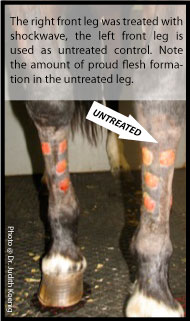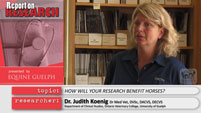ARCHIVE EQUINE NEWS STORIES
| Current news is available at TheHorsePortal.ca, Equine Guelph's online learning platform for practical, quick learning. Given the vast amount of information on horse health and welfare, Equine Guelph has archived its past news articles from 2002-2020. They are listed below, along with a search function available to find specific healthcare topics. | |
Shock Waves for Speedy HealingMay 2012
Click here for Report on Research Video Volume 5
Dr. Koenig began studying shock wave treatment when a particular horse with a broken leg came in for treatment. Koenig was interested in all the work that had been done in humans using shock wave therapy and preceded with her studies using a wound healing model.
 Koenig has found shock wave treatment beneficial in reducing proud flesh in large wounds, if used immediately after injury occurs. “Although the treatment is expensive,” says Koenig, “savings can be realized in reducing stall rest time and eliminating the cost of treating proud flesh after wound healing.”
Koenig has found shock wave treatment beneficial in reducing proud flesh in large wounds, if used immediately after injury occurs. “Although the treatment is expensive,” says Koenig, “savings can be realized in reducing stall rest time and eliminating the cost of treating proud flesh after wound healing.”
Horses are known to have a long and weak inflammation phase post-injury especially in their limbs. Shock waves work in wound and tendon healing by inducing a stronger inflammation in the tissue for a shorter healing time. Although it is not fully understood how shock wave treatment works, the theory is shockwaves are acoustic waves that are created by a shockwave generator and travel through fluid in the shockwave head. These acoustic waves create shear forces when they meet tissue of a different density (i.e. tendons) which release gas bubbles on the cell surface and release inflammatory mediators and growth factors. Koenig’s challenge has been attempting to measure the up and down regulation of growth factors to support the research.
Funding for this research has been provided by a grateful thoroughbred owner who donated the equipment and Equine Guelph.
Read - Dr. Judith Koenig biography & Published Papers
Funding for the Help for Horse Owners videos has been provided by the Knowledge Translation and Transfer Program under the OMAFRA-U of G Partnership.

